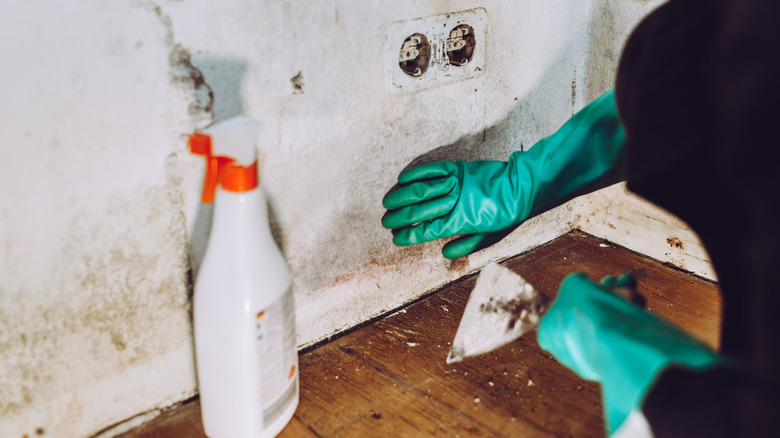Why Do People Use Grapefruit To Get Rid Of Mold & Does It Actually Work?
People like to seek out natural products to clean with. For instance, many try and use common household ingredients that can be used to clean the kitchen. These kinds of everyday substances are typically harmless to the body and the atmosphere and mean less toxins in the home, so people usually prefer to go the all-natural route when they can. This is why the idea of grapefruit as a mold killer is attractive. However, it isn't effective and shouldn't be relied on for this. Michael Rubino, a mold and air quality expert, environmental wellness advocate, and founder of HomeCleanse, spoke exclusively to House Digest about the efficacy of this citrus ingredient when dealing with mold. "The claim that grapefruit seed extract (GSE) is a safe and natural way to get rid of mold is controversial and not strongly supported by scientific evidence," he said.
"Several studies have shown that GSE does exhibit some antimicrobial properties, particularly in lab settings. However, much of the antimicrobial activity attributed to GSE in commercially available products has been found to be due to synthetic additives like benzethonium chloride rather than the extract itself. These synthetic compounds are often not disclosed on the labels," he continued. Because of this type of misinformation, grapefruit seed extract can't be relied on to get rid of mold.
Grapefruit can't be used to get rid of or prevent mold
When speaking exclusively with House Digest, Rubino explained that there isn't enough evidence that grapefruit can be used to get rid of mold. "Using GSE as a mold remover might not be effective and could pose safety concerns, especially given the potential for undisclosed synthetic additives. More studies are needed to understand the effectiveness of this extract better," he said. When asked if grapefruit seed extract can be used to prevent mold growth, he said there isn't a lot of information about that either. "Some studies have shown that it can be used as an antifungal, but scientists suggest more research be done."
It's better to stick to sure products and substances. Rubino shared that he uses Benefect Decon 30, a botanical cleaner. "I personally use products that have been scientifically proven to eliminate mold and its byproducts from the surface, like Benefect Decon 30. This product uses Thymol and a combination of surfactants to eliminate mold growth and particles from a surface," he explained. "I suggest using botanical products with surfactants proven to eliminate contaminants from a surface and a microfiber towel. From there, it's about using the proper procedures."
How to effectively get rid of mold
To kill mold spores effectively, Rubino said you need to first address the source and what made the environment conducive for its growth. Then, it should be removed completely. "Proper remediation means all contamination must be eradicated, including the colony, roots, dead mold particles, mycotoxins, and any bacteria. If this is not done, the microbial growth may persist, and the area will still be contaminated with harmful microscopic particles," Michael Rubino explained in his exclusive interview with House Digest.
There are several signs it's time to hire a professional to address a mold problem. Rubino says homeowners should start worrying when the mold has become larger than 10 feet wide and long. "Start with an at-home test like The Dust Test to determine what species are present and in what quantities," he said. "From there, hire an inspector to examine the space thoroughly, locate the sources, determine how far it has cross-contaminated throughout the house, figure out what led to the issue, and draft a protocol for the remediation team. From there, a remediation team can eliminate the contamination." You can also call them as soon as you notice some of the most common types of mold that can grow in a home.
How to DIY mold removal
If you can tackle it yourself, Rubino advised that you should first identify the type of surface you're working with so you can then follow the appropriate procedure. "For non-porous surfaces like sealed countertops, apply a botanical cleaner (such as Benefect Decon 30), let it sit for 30 seconds, and then wipe it with a microfiber towel," he explained while speaking exclusively with House Digest. "Microfiber towels are 100 times more effective than regular rags at removing tiny particles. Repeat this process at least two more times to ensure all contaminants, including mycotoxins, are removed. Use the clean side of the cloth every time." He also says to always use protective gear when removing mold.
Rubino then presented guidelines for dealing with semi-porous surfaces. "Mold roots (called hyphae) can penetrate the material, making it difficult to remove completely. To ensure the surface is contaminant-free, all particles and the root system must be removed," he explained. "Think of it like removing a weed. Use the same technique as non-porous surfaces, and seal the surface if possible. For some surfaces like hardwood, abrasive methodologies like sanding should be completed to remove the roots before sealing. Monitor the surface to ensure the mold does not return quickly, indicating a deeper issue that may require professional help or replacement of the surface. Remove and replace the material for porous surfaces like drywall, clothing, or fabric furniture. The contamination can exist deep within the fibers and be impossible to remove altogether. Discarding and replacing porous surfaces/items like clothing is also best."



